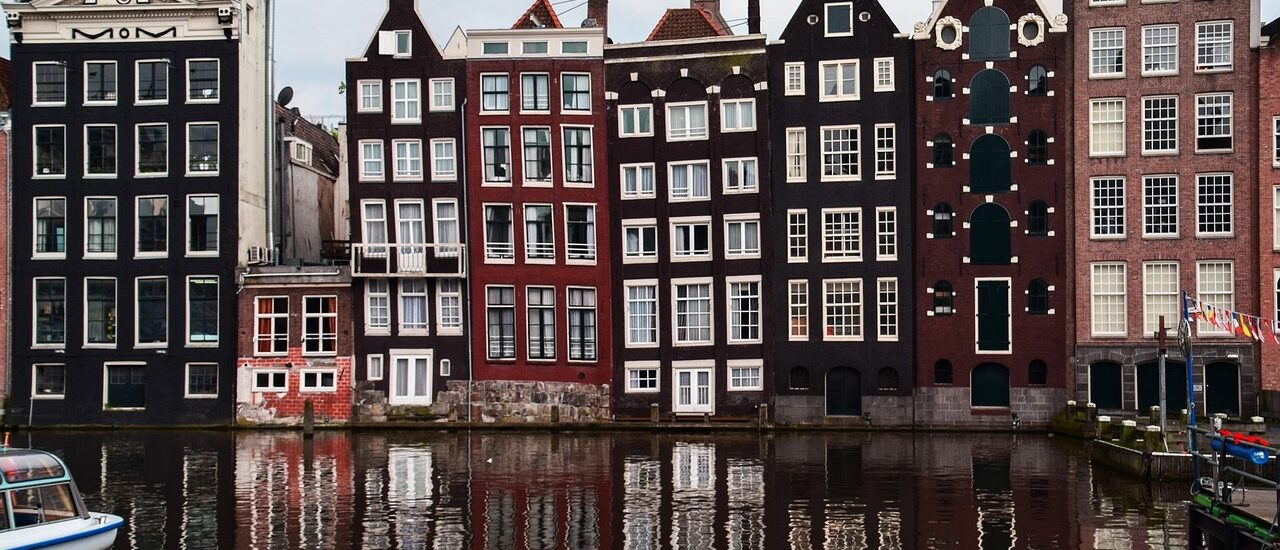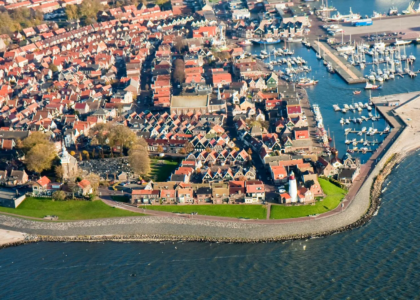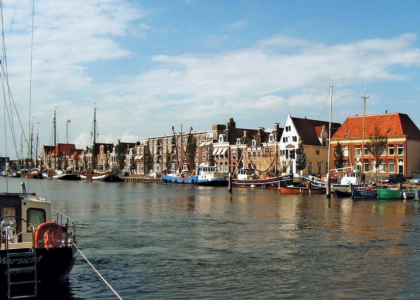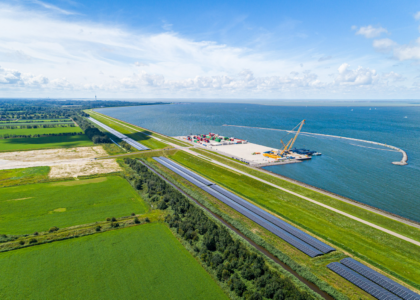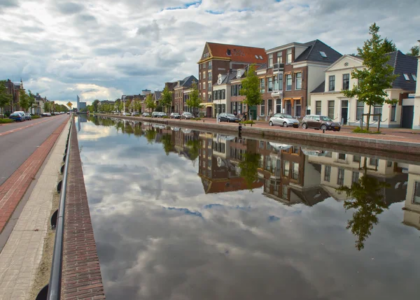Amsterdam, the captivating capital of the Netherlands, effortlessly combines historical charm with a progressive spirit. Renowned for its scenic canals, tulip-lined streets, and world-class museums, this vibrant metropolis attracts millions of tourists annually.
However, Amsterdam, also known as “the Dutch Capital,” “City of Bikes,” “Dam,” and “Mokum,” is more than just picture-perfect views.
Top 10 Facts about Amsterdam
In this article, we will explore lesser-known facts about the Dutch Capital, uncovering its unique characteristics and astonishing city traditions.
Fact 1: Amsterdam was originally a fishing village
Dam boasts a rich history dating back to the 13th century.
<alt=” a street in Amsterdam”/>
While various factors contributed to its transformation into a thriving cultural and economic hub, the city was initially a modest fishing village that emerged around that time:
- Such beginnings were typical for many cities in the Netherlands and Europe, often starting as humble settlements and later evolving into powerful urban centers;
- The early inhabitants of the Dutch Capital had to defend themselves against frequent floods, which were a constant challenge in the region. They built dams and canals that drained the marshy land surrounding the city, providing a reliable transportation network for goods and people. Over time, Dam grew into a bustling trading center, attracting merchants from around the world and fostering a distinctive culture that has endured to this day;
- According to historical records, the name “Amsteldamme” first appeared in a toll concession dating back to the 13th century. This indicates that the settlement already existed at that time, most likely as a small fishing village. The exact origin of the Dutch Capital remains unclear, but it is believed that over the subsequent centuries, the city rapidly expanded due to its strategic location and prosperous economy.
Today, Amsterdam is a vibrant and diverse city that annually draws millions of tourists. It is renowned for its scenic canals, charming architecture, and world-class museums, such as the famous Rijksmuseum and Van Gogh Museum.
Despite its transformation into a modern city, Amsterdam has managed to preserve much of its history and traditional culture, making it an intriguing destination for travelers seeking to explore the past and present of one of Europe’s most remarkable cities.
Fact 2: Amsterdam used to be called Amstelredamme
The capital of the Netherlands is known for its vibrant culture, picturesque canals, and iconic architecture. However, many are surprised to learn that Amsterdam wasn’t always called by its current name. In fact, it used to be known as Amstelredamme, shedding light on the origin of this historic city:
- The name refers to the dam built on the river Amstel, which was a significant factor in the city’s development;
- The construction of the dam allowed the Dutch Capital to flourish as an important trading city. Its prosperity began in the 13th century, as its location on the Amstel River provided easy access to trade routes connecting Northern Europe with the Mediterranean;
- Over time, the city’s name gradually evolved from Amstelredamme to Amsterdam, although the exact reasons for the name change remain uncertain. Some historians believe it simply resulted from the evolution of language, while others speculate it may have been influenced by changes in the city’s political and economic landscape.
Despite the name change, the Dutch Capital remains a city with a fascinating history and a rich cultural heritage. From its origins as a small trading town to its present-day status as a globally renowned center for trade, culture, and innovation, Amsterdam’s name stands as a testament to the enduring legacy of a city that has shaped world history.
Fact 3: Amsterdam’s canals were not originally designed for boats
Indeed, Mokum’s canals were not initially intended for boats. While today we associate Dam’s canals with boats and water transport, they were actually designed for practical reasons. In the 17th century, the city rapidly expanded and faced the challenge of frequent flooding.
Engineers constructed the canals to drain the marshy land and create space for construction. Additionally, the canals facilitated the transportation of goods to different parts of the city. Later, boats became a means of travel on the canals, but they were not part of the original plan.
Fact 4: Amsterdam has more canals than Venice
Mokum, a city renowned for its numerous canals, plays a significant role in the architecture and history of the city. Many people often compare Dam to Venice, another city known for its canals. However, what many don’t know is that the City of Bikes actually has more canals than Venice:
- Located in the Netherlands, Amsterdam is a city built on a network of waterways. It is often referred to as the “Venice of the North,” and for good reason. Amsterdam boasts over 165 canals, surpassing the approximately 150 canals in the Italian city of Venice. In addition to the numerous canals, Dam is home to over 1000 bridges, connecting various parts of the city;
- The canals of the Dutch Capital were constructed in the 17th century to facilitate trade and commerce. They transported goods such as grain, wine, and spices to the city’s port, which was one of the busiest in the world during the Dutch Golden Age. The canals also served as a defensive measure, as they could be drained to prevent enemy ships from attacking the city;
- Today, Dam’s canals are an integral part of its uniqueness and have contributed to the city’s inclusion on the UNESCO World Heritage List. Along the canals, impressive merchant houses stretch, many of which were built during the Dutch Golden Age. These houses showcase unique and beautiful architectural styles, ranging from Renaissance to Baroque, reflecting the city’s rich history and culture.
Amsterdam’s canals also serve as important means of transportation and leisure. Many locals and visitors enjoy boat tours to explore the city’s waterways and see its iconic landmarks from a different perspective. The canals are also home to numerous houseboats, providing unique and cozy accommodations for those seeking an alternative to traditional housing.
Fact 5: The Torensluis Bridge is the widest bridge in Amsterdam
The Torensluis Bridge, also known as the Tower Bridge or Tower Castle, is the widest bridge in the City of Bikes, spanning approximately 42 meters. It is one of the oldest bridges in the city, with its construction dating back to the mid-17th century.
Initially, it served as a marketplace. The Torensluis Bridge is a popular tourist attraction, renowned for its unique architecture and history:
- The Torensluis Bridge is a prominent landmark located in the heart of the city. It connects the bustling streets of Singel with the vibrant trading district of Raadhuisstraat;
- Stretching over the beautiful and historic Singel Canal, the Torensluis Bridge stands as the largest and widest bridge in the Dutch Capital. It features a light-colored stone arch supported by a series of tall gray columns, creating a striking contrast with the lush greenery and calm waters of the canal;
- Throughout the centuries, the Torensluis Bridge has witnessed significant historical events. During World War II, a group of Dutch resistance fighters used the bridge to transport Jewish children from Amsterdam to safe havens in rural areas. In 1987, a young Dutch activist fighting against AIDS disrupted traffic on the bridge to draw attention to the epidemic;
- Today, the Torensluis Bridge is a popular spot for tourists who come to admire its beauty and historical significance. It is also a favored location for street performers, artists, and musicians who entertain visitors with their skills and talents.
Despite its age, the Torensluis Bridge remains an important and functional part of Amsterdam’s transportation network, with thousands of locals and tourists crossing it daily. The bridge symbolizes the city’s rich history, character, and charm, and it is a must-visit for anyone exploring the vibrant and fascinating city of the City of Bikes.
Fact 6: Amsterdam has more bikes than people
The city has long established itself as one of the most bicycle-friendly cities in the world. According to experts’ estimates, there are more bicycles in it than people:
- According to the search results, Amsterdam is home to approximately 881,000 bicycles, while the city’s population is just over 821,000 people;
- Bicycles have been an integral part of Dam’s culture for over a century. The flat terrain, compact size of the city, and extensive network of bicycle lanes make it an ideal place for cycling. Cyclists in Amsterdam feel free and independent, an experience that is often hard to find in other cities. They can easily navigate through traffic, avoid crowds, and explore the city’s landmarks at their own pace;
- Mokum’s love for bicycles is reflected in its infrastructure. The city boasts over 400 kilometers of bicycle lanes, many of which are separated from motorized traffic. Cyclists have priority at intersections, and bicycle parking facilities can be found in almost every corner of the city. In the Dutch Capital, a bicycle is more than just a mode of transportation; it is a way of life;
- Cycling is an eco-friendly and healthy means of getting around the city. By choosing bicycles over cars, the residents reduce their carbon footprint while engaging in physical activity. The city actively promotes cycling as a mode of transportation, providing free or affordable bicycle parking and incentivizing employers to encourage their employees to cycle to work.
With its extensive network of bicycle routes, environmental consciousness, and social and cultural significance, the bicycle in Dam is not just a mode of transportation but an integral part of the city’s identity. So, the next time you find yourself in Amsterdam, why not rent a bicycle and join the locals in experiencing the city on two wheels?
Fact 7: Amsterdam is home to the world’s narrowest house
Mokum is full of unique and fascinating attractions, but one of its most iconic landmarks is the world’s narrowest house. Located in the historic city center on a bustling shopping street, the “Narrowest House,” or “Blinkende Eenhoorn” as it is called by locals, is a true Amsterdam oddity and an impressive architectural masterpiece:
- At its widest point, the house measures just 2.02 meters, making it difficult to imagine how one could live inside. However, the house is deceptively spacious, with a total living area of approximately 30 square meters spread across four floors. Originally built in 1738 as a diamond cutters’ workplace, it was later converted into a residential dwelling;
- Over the years, the narrow house has become an emblem of the city and a popular tourist attraction. Its distinctive shape and colorful façade are hard to miss, and visitors often stop to take photos and admire its architecture. Despite its narrowness, the house hosts art exhibitions, film screenings, and other events showcasing the versatility of this unique space.
The world’s narrowest house in Dam is just one example of the city’s innovative approach to architecture. The historic center of Amsterdam is known for its unconventional buildings, narrow alleyways, and unique canal houses, all contributing to the city’s distinct character. The city’s architecture reflects its vibrant and progressive spirit, as well as its long history as a center of trade and culture.
Fact 8: The Royal Palace was originally built as a city hall
The Royal Palace in Mokum was constructed in the 17th century as the city hall for the city of Amsterdam. Designed by architect Jacob van Campen, it was inspired by classical architecture. The building was completed in 1655 and served as the city’s town hall for over 150 years.
In 1808, the building became the property of Louis Napoleon, the brother of French Emperor Napoleon Bonaparte, and was transformed into a palace. Today, the Royal Palace is one of Dam’s most prestigious landmarks and is used by the Dutch royal family for state visits, ceremonies, and other important events.
The Royal Palace in the city, also known as the Koninklijk Paleis Amsterdam, is one of the grandest buildings in the city and a major tourist attraction. For over 150 years, the palace served as the city hall of the City of Bikes before being converted into a royal palace in 1808:
- Today, the Royal Palace is an important cultural and historical site in Mokum. Visitors can explore the palace’s grand halls, including the Marble Hall with impressive marble columns and a unique ceiling painting by Jacob de Wit. The palace also houses numerous magnificent artworks, including works by renowned Dutch painters such as Ferdinand Bol and Govert Flinck;
- In addition to its cultural and historical significance, the Royal Palace is a significant venue for state and ceremonial events. It is used by the Dutch royal family for state visits, award ceremonies, and receptions, as well as hosting annual festivities on King’s Day.
Visitors to the palace can admire an impressive collection of historical objects, including Napoleon’s throne, which is still on display in the throne room of the palace.
Fact 9: Amsterdam lies below sea level
The city is known for its unique characteristics. One interesting fact that sets Amsterdam apart from other cities is that it is located below sea level.
Many people are surprised to learn that Amsterdam is built on a series of artificial platforms. The city is situated on the banks of the IJ River, which is to the east of the city center. To protect the city from floods, a series of canals were constructed in the 16th and 17th centuries. These canals were designed to drain excess water and stabilize the ground on which the city was built:
- Originally, Amsterdam was constructed on marshy and swampy terrain, which made it challenging to maintain stable ground for construction and development. To combat this, Dutch engineers built a series of polders or artificial lands on the marshy terrain. These polders, located below sea level and the water level in the surrounding rivers, are kept in place by dams and dikes;
- Despite being located below sea level, Dam is not at significant risk of flooding. The fact that the city is built on polders means that it is well-protected from floods, as the canals and dikes are designed to safeguard the city and prevent water from entering;
- The fact that Amsterdam is situated below sea level has also influenced the city’s construction and architecture. The unique geographic position of Mokum has contributed to the formation of the city’s architectural style, characterized by narrow and tall houses.
Buildings in Amsterdam are constructed with foundations that adapt to the topography, ensuring the stability and structural integrity of the buildings.
Fact 10: Amsterdam is one of the safest cities in the world
Amsterdam is widely regarded as one of the safest cities worldwide. It attracts travelers from all over the globe due to its low crime rate and welcoming atmosphere:
- The city’s reputation as a safe destination is attributed to several factors. One of them is the high level of public safety. The Amsterdam police force is well-trained and committed to ensuring the safety of both residents and visitors. As a result, the city boasts a low crime rate, making it one of the safest European cities for tourists;
- Another contributing factor to Amsterdam’s safety is its well-developed infrastructure. The city has an extensive public transportation system, including buses, trams, and trains, enabling quick and secure movement throughout the urban area;
- Furthermore, Dam is a pedestrian and cyclist-friendly city, with well-lit streets and bicycle lanes, facilitating easy and safe mobility at any time of day or night;
- The strong sense of community in Mokum also enhances the city’s safety. The locals are friendly and hospitable, creating an environment where tourists can feel comfortable and secure while exploring the city;
- Finally, the active nightlife in Dam is another factor contributing to its safety. The city is known for its numerous bars and clubs, renowned for their relaxed and welcoming atmosphere. The presence of police and security personnel in these establishments helps prevent undesirable incidents.
The well-deserved reputation of Amsterdam as one of the safest cities in the world is a result of investments in public safety, well-developed infrastructure, vibrant nightlife, and a friendly society. These factors make the city a pleasant and essential destination for travelers seeking a safe and welcoming place to visit. If you are looking for a secure and captivating city to explore, Amsterdam is definitely worth considering.
Final Thoughts
Amsterdam is a city with a rich and captivating history. From its humble beginnings as a fishing village to its current status as a vibrant cultural hub, Dam has evolved and grown in remarkable ways over the centuries.
While the City of Bikes is perhaps best known for its canals and tulips, there is much more to the city than these symbols. The city is home to numerous museums, galleries, historical sites, and cultural attractions, where everyone can find something interesting and engaging.
Mokum is renowned for its tolerance and openness, with a long history of embracing diverse cultures, religions, and lifestyles. This makes it a welcoming and inclusive place to visit, with a strong sense of community and respect for diversity.
The unique geography of Dam with its canals and water arteries has shaped the city’s distinctive character. The City of Bikes, with its numerous bridges and narrow streets, possesses a charm and character that is unlike many other cities in the world.
Lastly, Mokum is a city that is constantly evolving, with new developments and innovations emerging all the time. Whether you are interested in the city’s rich history or exploring the latest advancements in art or technology, Amsterdam is a city that is sure to charm and inspire.

